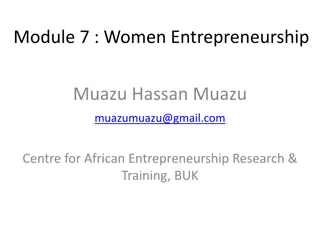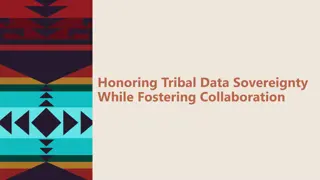Empowering Rural Tribal Women Through Sustainable Entrepreneurship
Empowering women in rural tribal areas by addressing factors like poverty, low literacy, lack of healthcare, and limited job options. Providing solutions such as enhancing production, diversifying livelihood options, and strengthening market linkages through capacity building and value chain development.
Download Presentation

Please find below an Image/Link to download the presentation.
The content on the website is provided AS IS for your information and personal use only. It may not be sold, licensed, or shared on other websites without obtaining consent from the author.If you encounter any issues during the download, it is possible that the publisher has removed the file from their server.
You are allowed to download the files provided on this website for personal or commercial use, subject to the condition that they are used lawfully. All files are the property of their respective owners.
The content on the website is provided AS IS for your information and personal use only. It may not be sold, licensed, or shared on other websites without obtaining consent from the author.
E N D
Presentation Transcript
25 years of Empowering Women, Building them as Entrepreneurs
Overview of problems of rural tribal women in Project Area Factors responsible for poverty Low literacy, patriarchal mindsets, high population, religion & caste discrimination Poor health facilities leads to poor health and incidence of malnutrition Depletion of natural resource for survival (Agri, NTFP & livestock) Lack of knowledge and skills to tap better opportunities Poor governance support Alcoholism and left wing extremism Lower & remotely disaggregated production at high cost of production Poor quality of land and infrastructural support to natural resource based income generation avenues Limited Job Options Traditional cultivation practices with meager exposure to new technologies and improved/ scientific practices Poor support from financial intermediaries (loans/credit) Lack of knowledge on technology, Value addition and authentic market information Economy of scale and scope Exploitation by traders (under weighing, unfair grading and opportunist pricing) Lack of basic infrastructure (warehouses, transport facilities, packaging material Factor affecting higher income Factors affecting market linkages for rural-tribal women
Services to address problems Enhance production Process up-gradation Scientific methods of cultivation for Farm, NTFP, Livestock based enterprises Basket approach: adding compatible products value chains Deliver business services to achieve economy of scale Capacity building at key nodes of Value chain Product up-gradation establish processing unit for primary & secondary level federated women FPOs/ cooperatives/WEGs Standard operating mechanism- step guide from harvesting to primary/secondary value addition Diversify livelihood options Basket Approach or Economy of Scope for irreversible livelihood Compatible products locally suitable, technological feasible, environment friendly, affordable and appropriate to women and also have significant market value (lac, agri-crops, mushrooms, kitchen gardening/ BYP, NTFPs, micro enterprises) Strengthen market linkages Deliver BDS (advisory services, financial & market linkages, convergence and dovetailing with government schemes) Identifying multiple buyers (multiple products) to negotiate better with market and economic agents through women led cooperatives Train groups in conducting detailed market feasibility, exploring and using best market strategy for better negotiation
Enterprise Basket to diversify livelihood of rural-tribal women in Project Area Madhya Pradesh & Chhattisgar h Lac (PSCL) and Brood farm Livestock care services (vaccination, feeding and shelter practices) for backyard poultry and Goat Rearing Lac cooperatives
Geographical coverage and outreach Chhattisgarh 11,000 1 district/3 block/56 villages Madhya Pradesh 9,000 4 districts /5 blocks/106 villages No. beneficiaries No. of Districts/ Blocks Villages Enterprise Basket Lac (PSCL) 4,628 indirect lac producers 8,688 direct lac producers Brood farm 11 brood farms with 883 lac producers 7,684 direct lac producers 14 indirect lac producers 5 brood farms with 107 lac producers Lac cooperatives 1 cooperative formed with 19 lac producers Semialata plantation 116 lac producers Livestock services 12,907 (birds) and 6,437 (cattle) with 2,403 families In process 1,26,953 plants planted in 29.76 acre by 50,000 plants planted in 11.5 acre by 6 lac producers 21,943 (birds) and 6,608 (goats) with 3,557 families
Impacts Change in Behaviour Change in skill Adopted necessary business skills i.e. mobility, public speaking, bargaining, record keeping and etc. Saving habit and increased income through diversified activities Increased mobility for enterprise management BDSPs working as trainers to spread best practices Moved-up to the value chain to have more control on the value addition processes and better profit margins Change in Knowledge Adopted improved practice of vegetable cultivation, kitchen gardening, accessing livestock care services Increased production and reduced cost of production Adoption of better management practices for multiple enterprises (mushroom, vaccination services, NTFPs) Change in attitude Transition from collection to cultivation of lac and adoption of vaccination to birds/chicks Challenging social norms of a woman not being able to run a business Risk taking and competition facing ability enhanced Decision making in domestic and public sphere increased Access and control of women over cash increased Change in Policy The tools and equipment support to sustain NTFP production (including lac) is now supported by GoI. Semialata plantation is accepted and taken forward by Forest officials/Department and supported through MNREGS Discussion to incorporate Lac tress based farming system ( mainly semialata) under crop insurance is started at various forums
Impacts/Results Change in Institution Received best lac promotion institution award from honorable Chief Minister of Jharkhand Change in Environme nt Around 1 acre trees annually consumes the amount of carbon dioxide equivalent to the Oxygen annually inhaled by 18 person. 1.5 lac Semialata plants planted on 41.26 acre land.
Learning and experience Strong M&E systems need to be in placed to capture and document changes in people s lives Need to bring more products in the livelihood basket of rural-tribal women to ensure regular and increased flow of income (i.e. tamarind, chironjee, custard apple, drum- stick, gooseberry, mahua, cashew nuts) along with lac Promote entrepreneur /producer group led micro-enterprises in the value chains to ensure primary value addition Promotion of brood farms is must for sustainable lac production Convergence with government schemes for construction of poultry/goat shed and improved feeding practices and plantation of host trees Nutritional sensitive agriculture in addition to hygiene and sanitation which accounts for 40% of expenditure spent on meeting health expenditure. Link rural-tribal women to financial institutions & various government schemes for long term sustainability. Functional literacy is crucial for better management of enterprises
Way Forward Strengthen M&E system using mobile applications for real-time review of critical information for decision-making. Establishment of formal linkage among lac growers, processors/exporters and consumers Identifying appropriate government schemes, angel investors, CSR schemes to subsidize establishment of primary processing units at village /cluster level Following ministries will be targeted for specific policy issue: Ministry of tribal affairs for MSP for NTFPs Ministry of MSME for processing units Develop local dialect tuned audio-visuals to disseminate the key messages along with the functional literacy programme Strengthen model for building capacity of other NGOs and CBOs in enterprise development























